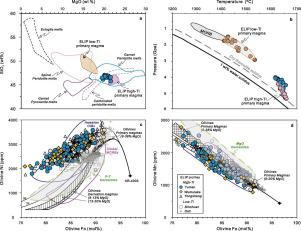Our official English website, www.x-mol.net, welcomes your
feedback! (Note: you will need to create a separate account there.)
Geochemistry of the Yumen picrites-basalts from the Emeishan large igneous province: Implications for their mantle source, PGE behaviors, and petrogenesis
Lithos ( IF 2.9 ) Pub Date : 2021-07-19 , DOI: 10.1016/j.lithos.2021.106364 Jun-Hua Yao 1, 2, 3, 4 , Wei-Guang Zhu 1 , Yan-Jun Wang 5 , Hong Zhong 1, 6 , Zhong-Jie Bai 1
Lithos ( IF 2.9 ) Pub Date : 2021-07-19 , DOI: 10.1016/j.lithos.2021.106364 Jun-Hua Yao 1, 2, 3, 4 , Wei-Guang Zhu 1 , Yan-Jun Wang 5 , Hong Zhong 1, 6 , Zhong-Jie Bai 1
Affiliation

|
Olivine compositions are often used to infer the source lithology of basaltic rocks, but the effect of source melting conditions on olivine chemistry remains poorly studied. Here we present mineral chemistry, whole-rock major and trace elements, SrNd isotopes, and platinum-group element (PGE) concentrations for high-Ti picritic-basaltic rocks from Yumen area. These data provide new constraints on the source lithology and petrogenesis of these high-Ti rocks in the Emeishan large igneous province (ELIP). The picrites have primitive compositional features (e.g., high Mg values, depleted SrNd isotopic compositions, no PGE depletions and/or fractionations). Some basaltic rocks have negative NbTa anomalies, enriched SrNd isotopic compositions, and depleted and/or fractionated PGE contents, indicative of fractional crystallisation, variable degrees of crustal contamination, and magmatic sulfide segregation. Combined with published data for the ELIP, the compositions of the primitive magmas and 10000Zn/Fe and FC3MS (FeO/CaO − 3 × MgO/SiO, all in wt%) values of the ELIP high-Ti picrites are similar to those of garnet peridotite-derived experimental melts. Based on the primitive magma compositions, the ELIP high-Ti melts could have been produced by mantle melting at 4.0–5.4 GPa and 1620–1660 °C, and started to crystallise olivine at 1410–1550 °C, based on the Al-in-olivine thermometer, which are higher temperatures than for mid-ocean ridge basalts and ELIP low-Ti magmas. The high-Ni and low-Mn olivine phenocrysts in the ELIP high-Ti samples crystallised from peridotite-derived, MgO-rich melts at high temperatures. Variations in the physicochemical source melting conditions was enough to explain the differences in olivine Ni and Mn contents in the ELIP high- and low-Ti picrites-basalts. Additionally, the almost constant Pd, Pt, and Rh contents with decreasing Mg values indicate intermediate partition behaviors in the ELIP magmas. No correlations exist between whole-rock 10,000 × Pd/Yb and Mg, (Th/Nb), and ε(t) values, implying that selective assimilation of crustal sulfur resulted in magmatic sulfide saturation. We propose that the ELIP high-Ti magmas were derived from a deep-sourced garnet peridotite, and experienced various igneous processes during ascent through the continental lithosphere to form different types of ELIP high-Ti basaltic rocks.
中文翻译:

峨眉山大型火成岩省玉门苦玄岩-玄武岩的地球化学:对其地幔来源、PGE行为和岩石成因的启示
橄榄石成分通常用于推断玄武岩的源岩性,但源熔化条件对橄榄石化学的影响仍然很少研究。在这里,我们介绍了玉门地区高钛苦苦玄武岩的矿物化学、全岩主量元素和微量元素、SrNd 同位素和铂族元素 (PGE) 浓度。这些数据为峨眉山大火成岩省(ELIP)这些高钛岩石的源岩性和岩石成因提供了新的约束。苦味铁矿具有原始的成分特征(例如,高镁值、贫化的 SrNd 同位素成分、无 PGE 贫化和/或分馏)。一些玄武岩具有负 NbTa 异常、富集的 SrNd 同位素组成以及贫化和/或分馏的 PGE 含量,表明分步结晶、不同程度的地壳污染和岩浆硫化物偏析。结合ELIP已发表的数据,ELIP高钛苦味石的原始岩浆成分以及10000Zn/Fe和FC3MS(FeO/CaO − 3 × MgO/SiO,均以wt%计)值与石榴石相似。橄榄岩衍生的实验熔体。根据原始岩浆成分,ELIP高钛熔体可能是由地幔在4.0~5.4 GPa、1620~1660 ℃下熔融产生的,并在1410~1550 ℃开始结晶橄榄石。 -橄榄石温度计,其温度高于洋中脊玄武岩和 ELIP 低钛岩浆。ELIP 高钛样品中的高镍和低锰橄榄石斑晶是在高温下从橄榄岩衍生的富含 MgO 的熔体中结晶出来的。物理化学源熔化条件的变化足以解释 ELIP 高钛和低钛苦铁矿玄武岩中橄榄石 Ni 和 Mn 含量的差异。此外,随着 Mg 值的降低,Pd、Pt 和 Rh 含量几乎恒定,表明 ELIP 岩浆中存在中间分配行为。全岩 10,000 × Pd/Yb 与 Mg、(Th/Nb) 和 ε(t) 值之间不存在相关性,这意味着地壳硫的选择性同化导致了岩浆硫化物饱和。我们认为ELIP高钛岩浆源自深源石榴橄榄岩,在穿过大陆岩石圈上升过程中经历了各种火成岩过程,形成了不同类型的ELIP高钛玄武岩。
更新日期:2021-07-19
中文翻译:

峨眉山大型火成岩省玉门苦玄岩-玄武岩的地球化学:对其地幔来源、PGE行为和岩石成因的启示
橄榄石成分通常用于推断玄武岩的源岩性,但源熔化条件对橄榄石化学的影响仍然很少研究。在这里,我们介绍了玉门地区高钛苦苦玄武岩的矿物化学、全岩主量元素和微量元素、SrNd 同位素和铂族元素 (PGE) 浓度。这些数据为峨眉山大火成岩省(ELIP)这些高钛岩石的源岩性和岩石成因提供了新的约束。苦味铁矿具有原始的成分特征(例如,高镁值、贫化的 SrNd 同位素成分、无 PGE 贫化和/或分馏)。一些玄武岩具有负 NbTa 异常、富集的 SrNd 同位素组成以及贫化和/或分馏的 PGE 含量,表明分步结晶、不同程度的地壳污染和岩浆硫化物偏析。结合ELIP已发表的数据,ELIP高钛苦味石的原始岩浆成分以及10000Zn/Fe和FC3MS(FeO/CaO − 3 × MgO/SiO,均以wt%计)值与石榴石相似。橄榄岩衍生的实验熔体。根据原始岩浆成分,ELIP高钛熔体可能是由地幔在4.0~5.4 GPa、1620~1660 ℃下熔融产生的,并在1410~1550 ℃开始结晶橄榄石。 -橄榄石温度计,其温度高于洋中脊玄武岩和 ELIP 低钛岩浆。ELIP 高钛样品中的高镍和低锰橄榄石斑晶是在高温下从橄榄岩衍生的富含 MgO 的熔体中结晶出来的。物理化学源熔化条件的变化足以解释 ELIP 高钛和低钛苦铁矿玄武岩中橄榄石 Ni 和 Mn 含量的差异。此外,随着 Mg 值的降低,Pd、Pt 和 Rh 含量几乎恒定,表明 ELIP 岩浆中存在中间分配行为。全岩 10,000 × Pd/Yb 与 Mg、(Th/Nb) 和 ε(t) 值之间不存在相关性,这意味着地壳硫的选择性同化导致了岩浆硫化物饱和。我们认为ELIP高钛岩浆源自深源石榴橄榄岩,在穿过大陆岩石圈上升过程中经历了各种火成岩过程,形成了不同类型的ELIP高钛玄武岩。











































 京公网安备 11010802027423号
京公网安备 11010802027423号